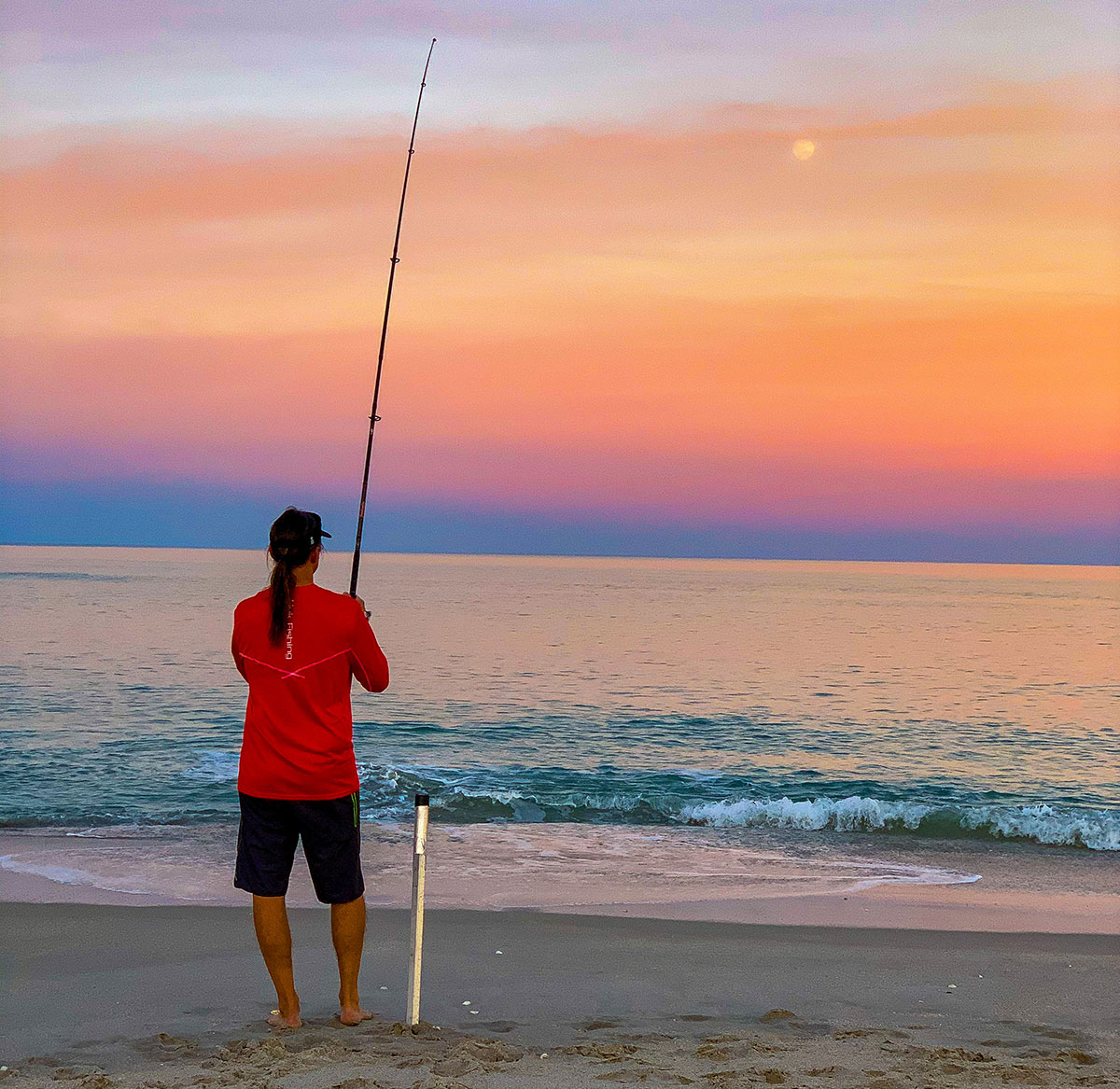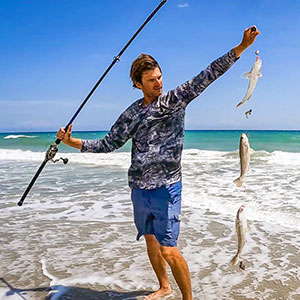Falling hook, line and sinker

With 72 miles of coastline in Brevard, there are plenty of great hot spots to catch a variety of excellent species while surf fishing. GINA RAGAN
Brevard beaches are a great place for surf fishing
With 72 miles of beaches, the Space Coast offers plenty of opportunities for surf fishing. With calmer seas and warmer weather, summertime can be one of the best seasons for newbies and youth to learn the sport.
There is plenty of free advice and information available — from resources that can be accessed online to professional Surf Charter guides to area bait and tackle fishing outlets. The good news is that it doesn’t have to cost a lot when first getting started.
“Fishing is not hard, fish will eat anything at any time,” said Joey Antelloni, a longtime Brevard fishing guide and expert angler.
Born and raised in Palm Bay, Antelloni learned to fish with his father and grandfather on the beaches of Indialantic. He has since made fishing his career. The most important advice he offers is to be patient, safe and have fun.
Known as the YouTube guru of fishing on the Space Coast, Antonelli has been sharing his knowledge and fish stories via the web since 2006. He has reeled in nearly a half-million viewers who regularly visit and subscribe to his site.
He also was a guest speaker at the Florida Sport Fishing Association meeting in April where he shared his knowledge of surf fishing — from baits, tackle, rod selection, best spots and more.
WHERE TO FISH

Treble hooks are a great choice for landing multiple fish with a single cast. JOEY ANTONELLI
All of the beaches along the coastline in Brevard are divided into several sections, based on topography.
Troughs form offshore from the shore break, and they can vary, depending on the slope or steepness of the beach into the water.
At the north end — from the Canaveral National Seashore [New Smyrna to Port Canaveral] — the bottoms are sandy and these troughs are less pronounced.
From Patrick Air Force Base in Satellite Beach south to Indialantic, there are coquina ridges. Attached to these small, reef-like structures, are colonies of sabellariid worms. Farther south, from Melbourne Beach to Sebastian Inlet, the troughs become more pronounced, as the slopes are more vertical.
As shallow water from sandbars prevents water from flowing back to the ocean, the incoming pressure grows inside these troughs — until it forces breaks.
For swimmers, this scenario can cause dangerous rip currents, but for surf fishing anglers it can provide a gold mine where small invertebrates such as sand fleas and other bait fish are dislodged among the waves. Predatory fish wait along the edges of the bars to feed, creating a super fish highway.
Everything from whiting, croakers, pompano, bluefish, mackerel and even snook can be found lurking along these troughs.
“Seasonal rules relating to bag limits and species also come into play,” Antonelli said. “Before venturing out to the beach, it’s always a good idea to check the forecast, water conditions, tide tables, and wind direction.
“Offshore winds make it easier to cast, and the water is clearer, but the fish tend to stick in deeper waters during the daylight, and venture inland at dusk. Nearly all species are more active during lower light levels, and these times can maximize chances of success, especially during new or full moon tides.”
Because conditions change quickly with tides, it’s also nice to have fishing buddies who are willing to exchange information concerning the daily hot spots.

Surf fishing beginners will need a minimal investment that includes a rod, reel, some surf fishing rigs, rod holders, baits, a bucket and a small tackle box. GINA RAGAN
NECESSARY EQUIPMENT
Choice of bait and rigs can mean the difference between success and failure.
“When it comes to sending the bait over the waves, it’s just as important to consider the rig as deciding what baits to use,” Antonelli explained. “Whether you learn how to tie your own or purchase a professionally made one, it’s worth the initial investment to use one with fluorocarbon line. This type of line, when immersed in water becomes practically invisible.
“The rigs must be streamlined to allow for long cast, allowing the bait to flow naturally on the ocean floor, and firmly hold the bait. Essentially a lead weight, with one or several hooks and a barrel swivel can be used to catch a variety of species.”
“Treble hooks are a great choice for catching whiting and smaller species, and the experience of landing three fish at once can be a surf angler’s best memory,” he added.
Antonelli recommends checking out various websites such as www.go-salt-water-fishing.com or www.saltstrong.com to find information on popular choices, or to visit any retail tackle outlet for advice.
“There are several lengths of rods appropriate for surf fishing — and it is not always necessary to use a longer or heavier rod,” he said.
“A setup that allows casting further distances is necessary when fish are further out, with the average lengths of rods ranging from 7 feet to 12 feet. The tides and coastline features can determine distance and casting protocol. Surf fishing rods come in power levels ranging from medium to heavy and shorter rods can be used for casting when higher tides prevail.
“Rod action is measured by the point at which the rod starts to bend. Since most surf fishing entails the use of rod holders, it is not necessary to have a ‘fast action’ rod,” Antelloni explained.
“Either conventional bait casting types or spinning reels are commonly used, with the faster action surf rod ideal when using lures.”
As for reels, he suggested one that is equipped with a 25 to 50 pound braid [the preferred line type for surf fishing] that can hold 300 to 500 yards.
“The all-around medium action rod can be interchanged with smaller reels to catch everything from tarpon to bluefish and whiting, typically in the 2- to 5-foot range.

Artificial fish gum is a great alternative to live bait choices and can be used to catch most species. JOEY ANTONELLI
TASTY BAITS
Antonelli also said that while there are thousands of theories on what bait is best when it comes to surf fishing, like humans every fish has its own discriminating taste buds.
“My advice is to keep a log of what baits you have tried and the success you’ve had, noting what fish ate what, your best catches and the circumstances that revolved around the catch that may include what time of the day, etc.,” he said. “This goes for your rigs, floats, weights, and just about everything.
“While many species prefer live bait — shrimp, glass minnows, and native clams, scallops or sand fleas [which can often be found along the outside sandbars and onshore buried in the sand] — are considered best. However, frozen varieties, lures and artificial fish gum bites are also popular choices. The latter can hold better on a hook.
“Smaller varieties of Atlantic croakers are an excellent choice to catch coveted snook and pompano, touted as two of the best tasting varieties found in Space Coast waters. Local surf fishing reports are a great way to stay in-the-know about what’s biting, and where.”
He said that besides a rod and reel, other items that are helpful include a bucket, a cooler, a good fishing knife, needle-nose pliers, a fish hook puller, rod holders, a net and a small dedicated tackle assortment.

JOEY ANTONELLI PHOTO
SURF FISHING RESOURCES
For information about surf fishing along the Space Coast visit:
www.youtube.com/Joey Antonelli
www.myfwc.com/license
www.saltstrong.com
www.spacefishreport.com
www.spacecoastoutdoors.net
www.fsfa.org

Sue DeWerff Panzarino
Sue is an avid surfer, shark attack survivor and storyteller who loves to write about the wonderful people and great organizations on the Space Coast.




